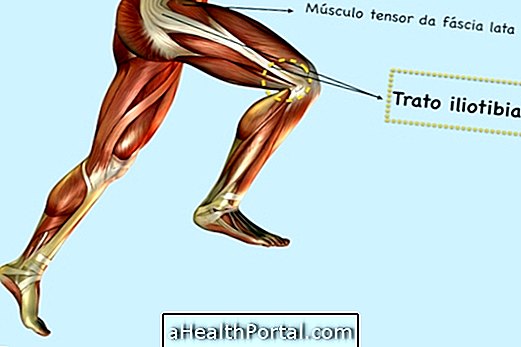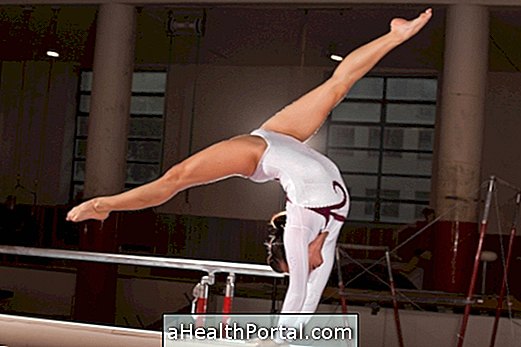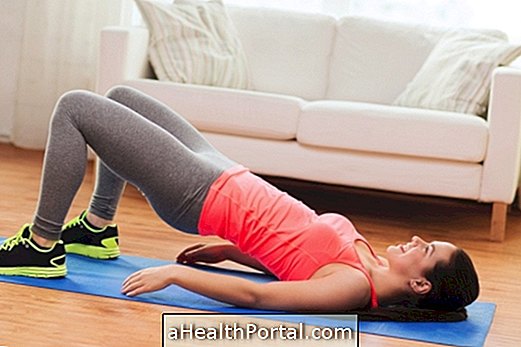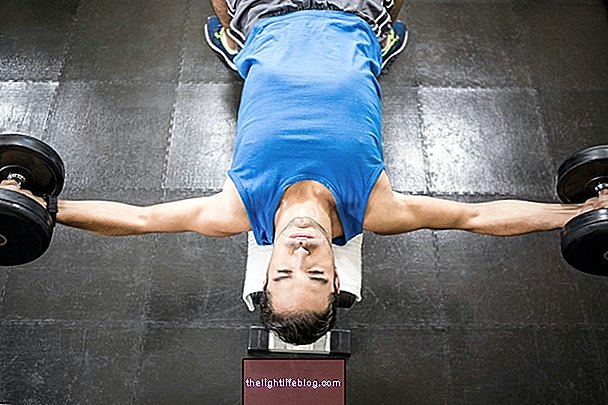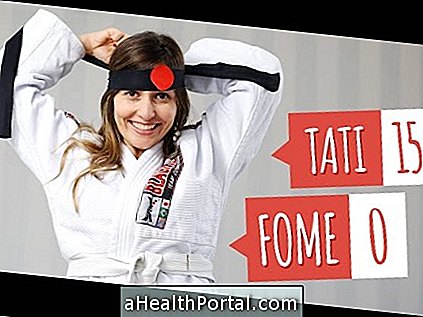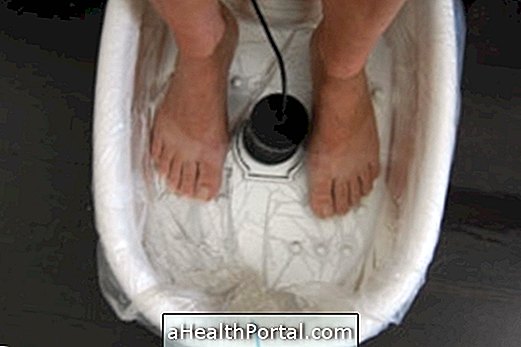Shoulder training at home is simple, easy and helps to achieve different goals, from toning, improving the stability and strength of the deltoid, trapezius and arm muscles, increasing muscle volume to shoulder hypertrophy and should be added to the exercise routine weekly.
For best results, these shoulder exercises should be done using weights like a pet bottle with sand or backpacks with a packet of rice or beans, or dumbbells, barbell or kettlebell, for example. However, it is important to take into account the physical conditions and limitations of the body to avoid any type of injury such as rupture of the deltoid or tendonitis, for example.
Therefore, the ideal is to make a medical evaluation before starting any physical activity and have guidance from a physical educator who must indicate the weight for each exercise individually.
How to do the shoulder workout
Shoulder training at home can be done 2 to 3 times a week, in 2 to 3 sets of 10 to 12 repetitions, depending on the exercise. The ideal is to choose 3 to 4 exercises per workout.
It is important to warm up before exercising, being a good option to move your arms up and down alternately, several times at a fast pace or to do jumping jacks, for example.
Some exercise options for doing a full shoulder workout at home are:
1. Flexion with elevated feet

Flexion with elevated feet is an exercise that helps to work the strength and resistance of the deltoids, triceps and biceps. To perform this exercise, you must use a surface to create body inclination such as stool, chair, puff, gym ball or a step exercise platform.
How to do it: support your feet on the sloping surface, and raise your body by stretching your arms, with your hands slightly wider than shoulder width apart. The body should be straight and with the back aligned with the torso. Contract your abdomen, flex your elbows until your chest is close to the floor and return to the starting position.
2. Lateral elevation

The lateral elevation works the strength and resistance of the deltoid, trapezius and infra-spinal muscles. This exercise should be done with the use of weight as a pet bottle with water or sand or backpacks with 1 or 2 kg of rice or beans in each one, or using dumbbells.
How to do it: standing, with your feet hip-width apart and your arms along your body, hold a weight in each hand. With your abdomen contracted, raise your arms to your sides, without flexing your elbows and with your palms facing down, until they are at shoulder level. Lower your arms slowly.
3. Front elevation

Front elevation is another good exercise option to work the strength and resistance of the deltoid and trapezius muscles, in addition to stimulating the increase in muscle mass and volume. To achieve these goals, weights must be used as a pet bottle with sand inside or two backpacks with packages of 1kg of rice or beans, for example, or dumbbells if you have them.
How to do it: with your arms aligned in front of your body, hold the weight with your palms facing inwards and shoulder width. It is important that the arms are fully stretched and the abdomen contracted. Lift the weight forward and up to the level of the shoulders, exhaling as the arms rise and inhaling as they descend. Return to the starting position.
4. Board with arm lift

The arm lift board is considered a complete exercise, as it works the strength and stability of the deltoids, abdomen, core and other body muscles such as the biceps and triceps. In this exercise it is not necessary to use weights or dumbbells.
How to do it: lie on your stomach and then raise your body, resting your hands and tiptoes on the floor, always with your abdomen and buttocks contracted and your head and body straight, aligned with your spine. Lift one leg, in line with the body and extend the opposite arm of the leg, for example, if you lift the left leg, extend the right arm forward. Return the arm to the starting position and then extend the arm to the side, keeping the leg elevated. Do 10 to 15 repetitions with your right arm and then with your left arm. This exercise is not done in series, however if the objective is to increase muscle strength, it can be done in 2 to 3 series. If the exercise is too difficult, you can do it without raising your leg.
5. Development

The shoulder development exercise allows you to strengthen and develop the anterior and lateral deltoid muscles, in addition to working on the triceps, the trapezius and the upper chest, being a good option for people who want shoulder hypertrophy. This exercise should be done with the use of weight as one or more packages of 1kg of rice or beans in a backpack, use a pet bottle with sand inside, for example, or use dumbbells, if you have them.
How to do it: sit on a bench or chair and place the weights so that the arm and forearm form a 90 degree angle. It is important that the palms of the hands are facing forward, the back always straight and the abdomen contracted. Lift the weights until your arms are straight and return to the starting position.
6. High row

The high stroke is an exercise that works with the strength, support and balance of the deltoid and trapezius muscles, in addition to the upper chest, and should be done with the use of weight as a pet bottle with water or sand inside or use a bar or dumbbells, if you have those materials.
How to do it: standing, with your legs shoulder-width apart, hold the bar in front of your body with your arms extended, palms facing the body, contracted abdomen and straight back. Pull the weight upwards, raising your elbow to shoulder height. Return to the starting position.
What to do after training
After shoulder training, stretching should be done to help relax the muscles, tone the muscles, improve flexibility, increase circulation and prevent injuries.
1. Stretch over the head

This stretching, allows to stretch the deltoids, trapezius, chest and spine, and must be done standing or sitting.
How to do it: raise one arm and bend your elbow, placing your hand towards your back or the back of your neck. With your other arm, pull your elbow toward your head to stretch your triceps. Do this movement for 20 to 30 seconds. Repeat with the other arm. This exercise is not done in series.
2. Stretch of crossed arms

Crossed arms stretch allows you to stretch your shoulder and bicep muscles.
How to do it: standing, with your legs shoulder-width apart and your knees slightly bent, place your right arm across your body, at shoulder height. With your left arm, hold your right arm in this position by pressing your right arm across your chest. Hold this position for 20 to 30 seconds and repeat with your left arm. You can do 3 to 4 repetitions for each arm.
Was this information helpful?
Yes No
Your opinion is important! Write here how we can improve our text:
Any questions? Click here to be answered.
Email in which you want to receive a reply:
Check the confirmation email we sent you.
Your name:
Reason for visit:
--- Choose your reason --- DiseaseLive betterHelp another personGain knowledge
Are you a health professional?
NoMedicalPharmaceuticalsNurseNutritionistBiomedicalPhysiotherapistBeauticianOther
Bibliography
- KIM, Mi-Kyoung; et al. The effects of shoulder stabilization exercises and pectoralis minor stretching on balance and maximal shoulder muscle strength of healthy young adults with round shoulder posture. J Phys Ther Sci. 30. 3; 373–380, 2018
- RONAI, Peter. Exercise Modifications and Strategies to Enhance Shoulder Function. National Strength and Conditioning Association. 27. 4; 36–45, 2005
- HOTTA, Kazuki; et al. Daily muscle stretching enhances blood flow, endothelial function, capillarity, vascular volume and connectivity in aged skeletal muscle. J Physiol. 596. 10; 1903–1917, 2018
- GEHM, David G .; CHAOUACHI, Anis. A review of the acute effects of static and dynamic stretching on performance. Eur J Appl Physiol. 111. 11; 2633-2651, 2011

